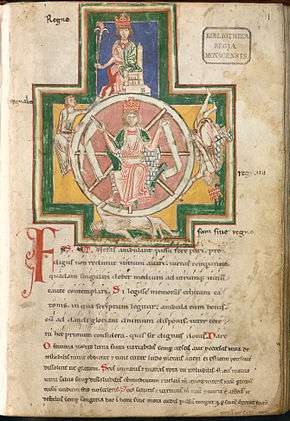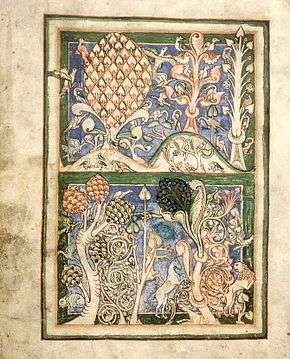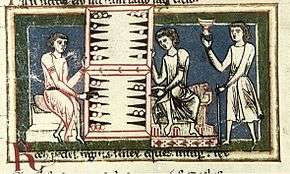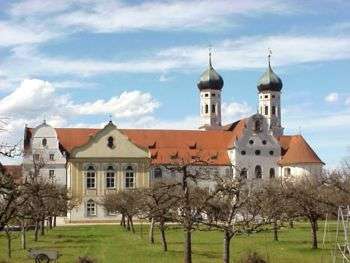Carmina Burana

Carmina Burana (/ˈkɑːrmɪnə
They were written by students and clergy when the Latin idiom was the lingua franca throughout Italy and western Europe for travelling scholars, universities, and theologians. Most of the poems and songs appear to be the work of Goliards, clergy (mostly students) who satirized the Catholic Church. The collection preserves the works of a number of poets, including Peter of Blois, Walter of Châtillon, and an anonymous poet referred to as the Archpoet.
The collection was found in 1803 in the Benedictine monastery of Benediktbeuern, Bavaria, and is now housed in the Bavarian State Library in Munich. It is considered to be the most important collection of Goliard and vagabond songs, along with the Carmina Cantabrigiensia.
The manuscripts reflect an international European movement, with songs originating from Occitania, France, England, Scotland, Aragon, Castile, and the Holy Roman Empire.[2]
Twenty-four poems in Carmina Burana were set to music by Carl Orff in 1936. His composition quickly became popular and a staple piece of the classical music repertoire. The opening and closing movement "O Fortuna" has been used in numerous films.
Manuscript
Carmina Burana (CB) is a manuscript written in 1230 by two different scribes in an early gothic minuscule[3] on 119 sheets of parchment. A number of free pages, cut of a slightly different size, were attached at the end of the text in the 14th century.[4] At some point in the Late Middle Ages, the handwritten pages were bound into a small folder called the Codex Buranus.[5] However, in the process of binding, the text was placed partially out of order, and some pages were most likely lost, as well. The manuscript contains eight miniatures: the rota fortunae (which actually is an illustration from songs CB 14–18, but was placed by the book binder as the cover), an imaginative forest, a pair of lovers, scenes from the story of Dido and Aeneas, a scene of drinking beer, and three scenes of playing dice, tables, and chess.[6]

History
Older research assumed that the manuscript was written in Benediktbeuern where it was found.[7] Today, however, Carmina Burana scholars have several different ideas about the manuscript's place of origin. It is agreed that the manuscript must be from the region of central Europe where the Bavarian dialect of German is spoken due to the Middle High German phrases in the text—a region that includes parts of southern Germany, western Austria, and northern Italy. It must also be from the southern part of that region because of the Italian peculiarities of the text. The two possible locations of its origin are the bishop's seat of Seckau in Styria and Kloster Neustift near Brixen in South Tyrol.
A bishop named Heinrich was provost in Seckau from 1232 to 1243, and he is mentioned as provost of Maria Saal in Carinthia in CB 6*[8] of the added folio. This would support Seckau as the possible point of origin, and it is possible that Heinrich funded the creation of the Carmina Burana. The marchiones (people from Steiermark) were mentioned in CB 219,3 before the Bavarians, Saxons, or Austrians, presumably indicating that Steiermark was the location closest to the writers. Many of the hymns were dedicated to Saint Catherine of Alexandria, who was venerated in Seckau, such as CB 12* and 19*–22*.[9]
In support of Kloster Neustift, the text's open-mindedness is characteristic of the reform-minded Augustine Canons Regular of the time, as is the spoken quality of the writing. Also, Brixen is mentioned in CB 95, and the beginning to a story appears in CB 203a which is unique to Tirol called the Eckenlied about the mythic hero Dietrich von Bern.[10][11][12]
It is less clear how the Carmina Burana traveled to Benediktbeuern.[13] Fritz Peter Knapp suggested that the manuscript could have traveled in 1350 by way of the Wittelsbacher family who were Vögte of both Tirol and Bavaria, if it was written in Neustift.[12]
Themes
Generally, the works contained in the Carmina Burana can be arranged into four groups according to theme:[5]
- 55 songs of morals and mockery (CB 1–55)
- 131 love songs (CB 56–186)
- 40 drinking and gaming songs (CB 187–226)
- two longer spiritual theater pieces (CB 227 and 228)
This outline, however, has many exceptions. CB 122–134, which are categorized as love songs, actually are not: they contain a song for mourning the dead, a satire, and two educational stories about the names of animals. Another group of spiritual poems may have been included in the Carmina Burana and since lost.[14] The attached folio contains a mix of 21 generally spiritual songs: a prose-prayer to Saint Erasmus and four more spiritual plays, some of which have only survived as fragments. These larger thematic groups can also be further subdivided, for example, the end of the world (CB 24–31), songs about the crusades (CB 46–52) or reworkings of writings from antiquity (CB 97–102).
Other frequently recurring themes include: critiques of simony and greed in the church, that, with the advent of the monetary economy in the 12th century, rapidly became an important issue (CB 1–11, 39, 41–45); lamentations in the form of the planctus, for example about the ebb and flow of human fate (CB 14–18) or about death (CB 122–131); the hymnic celebration of the return of spring (CB 132, 135, 137, 138, 161 and others); pastourelles about the rape/seduction of shepherdesses by knights, students/clergymen (CB 79, 90, 157–158); and the description of love as military service (CB 60, 62, and 166), a topos known from Ovid's elegiac love poems. Ovid and especially his erotic elegies were reproduced, imitated and exaggerated in the Carmina Burana.[15] Following Ovid, depictions of sexual intercourse in the manuscript are frank and sometimes aggressive. CB 76, for example, makes use of the first-person narrative to describe a ten-hour love act with the goddess of love herself, Venus.[16]

The Carmina Burana contains numerous poetic descriptions of a raucous medieval paradise (CB 195–207, 211, 217, 219), for which the ancient Greek philosopher Epicurus, known for his advocation of the blissful life, is even taken as an authority on the subject (CB 211). CB 219 describes, for example, an ordo vagorum (vagrant order) to which people from every land and clerics of all rankings were invited—even presbyter cum sua matrona, or "a priest with his lady wife" (humorous because Catholic priests must swear an oath of celibacy). CB 215 even provides an example of the religious rites of this order, the Officium lusorum, the "Service", or "Mass", "of the Gamblers". In this parody world, the rules of priesthood include sleeping in, eating heavy food and drinking rich wine, and regularly playing dice games. These rules were described in such detail that older research on the Carmina Burana took these descriptions literally and assumed there actually existed such a lazy order of priests.[17] In fact, though, this outspoken reverie of living delights and freedom from moral obligations shows "an attitude towards life and the world that stands in stark contrast to the firmly established expectations of life in the Middle Ages."[18] The literary researcher Christine Kasper considers this description of a bawdy paradise as part of the early history of the European story of the land of Cockaigne: in CB 222 the abbas Cucaniensis, or Abbot of Cockaigne, is said to have presided over a group of dice players.[19]
Authors
Almost nothing is known about the authors of the Carmina Burana. Only a few songs can be ascribed to specific authors, such as those by Hugh Primas of Orléans (died c. 1160), by the Archpoet (died c. 1165), by Frenchman Walter of Châtillon (died c. 1201), and by Breton Petrus Blesensis (died c. 1203). Additionally, the attached folio contains German stanzas that mention specific authors, so they can be ascribed to German Minnesinger Dietmar von Aist (died c. 1170), to Heinrich von Morungen (died c. 1222), to Walther von der Vogelweide (died c. 1228), and to Neidhart (died c. 1240). The only signed poems are contained in the attached folio, and they are by the so-called Marner, a wandering poet and singer from Swabia. Many poems stem from works written in Classical antiquity by Ovid, Horace, Juvenal, and Ausonius; however, about two-thirds of the poems appear not to be derivative works.[20]
The text is mostly an anonymous work, and it appears to have been written by Goliards and vagrants who were either theology students travelling between universities or clerics who had not yet received a prebendary. Presumably these individuals scrounged and begged for a living, which might explain why a good portion of the moral songs are dedicated to condemning those who aren't generous alms givers (e.g., CB 3, 9, 11, and 19–21). The authors demonstrate a broad knowledge of ancient mythology, which they employ to rich effect through metonymy and allegorical references, and which they effortlessly weave into scenes from the Bible. Lyaeus, for example, the mythical god of wine (Dionysus), casually makes an appearance at the Marriage at Cana in CB 194 where Jesus performed the miracle of transforming water into wine (John 2:1–12).
Rediscovery and history of publication
The manuscript was discovered in the monastery at Benediktbeuren in 1803 by librarian Johann Christoph von Aretin. He transferred it to the Bavarian State Library in Munich where it currently resides (Signatur: clm 4660/4660a).[21][22] Aretin regarded the Codex as his personal reading material, and wrote to a friend that he was glad to have discovered "a collection of poetic and prosaic satire, directed mostly against the papal seat".[23]
The first pieces to be published were Middle-High German texts, which Aretin's colleague Bernhard Joseph Docen published in 1806.[24] Additional pieces were eventually published by Jacob Grimm in 1844.[25] The first collected edition of the Carmina Burana was not published until 1847, almost 40 years after Aretin's discovery.[26] Publisher Johann Andreas Schmeller chose a misleading title for the collection, which created the misconception that the works contained in the Codex Buranas were not from Benediktbeuren.[27] Schmeller attempted to organize the collection into "joking" (Scherz) and "serious" (Ernst) works, but he never fully completed the task. The ordering scheme used today was proposed in 1930 by Alfons Hilka and Otto Schumann in the first critical text edition of the Carmina Burana.[28] The two based their edition on previous work by Munich philologist Wilhelm Meyer, who discovered that some pages of the Codex Buranus had mistakenly been bound into other old books. He also was able to revise illegible portions of the text by comparing them to similar works.[29]
Musical settings
About one-quarter of the poems in the Carmina Burana are accompanied in the manuscript by music using unheighted, staffless neumes,[30] an archaic system of musical notation that by the time of the manuscript had largely been superseded by staffed neumes.[31] Unheighted neumes only indicate whether a given note is pitched higher or lower than the preceding note, without giving any indication of how much change in pitch there is between two notes, so they are useful only as mnemonic devices for singers who are already familiar with the melody. However, it is possible to identify many of those melodies by comparing them with melodies notated in staffed neumes in other contemporary manuscripts from the schools of Notre Dame and Saint Martial.[31]
Between 1935 and 1936, German composer Carl Orff composed music, also called Carmina Burana, for 24 of the poems. The single song "O Fortuna" (the Roman goddess of luck and fate), from the movement "Fortuna Imperatrix Mundi", is often heard in many popular settings such as films. Orff's composition has been performed by many ensembles.
Other musical settings include:
- 1584: A sanitized version of "Tempus adest floridum" was published in the Finnish collection Piae Cantiones. The Piae Cantiones version includes a melody recognizable to modern audiences as the one that is now used for the Christmas carol "Good King Wenceslas."
- 1949–1951:Matyas Seiber "Cantata Secularis:the Four Seasons" for SATB and orchestra.
- 1983: Album by Ray Manzarek, keyboard player for The Doors, produced by Philip Glass and Kurt Munkacsi; arrangements by Ray Manzarek. A&M Records.[32]
- 1991: Apotheosis, a techno group from Belgium, produced their first single, "O Fortuna", in 1991, which heavily sampled the classical piece originally composed by Carl Orff. However, the estate of Carl Orff (who died in 1982) took legal action in court to stop the distribution of the records on the grounds of copyright infringement. Judgment was finally accorded to the estate.[33]
- 1992–2014: German bands Qntal and Helium Vola set several hymns of Carmina Burana to electro-medieval music.
- 1993: East-German punk band Feeling B recorded a version of the song Veris Dulcis for their album Die Maske des Roten Todes.
- 1997: Japanese composer Nobuo Uematsu used portions of "O Fortuna", "Estuans interius", and "Veni, veni, venias" for the final boss theme "One-Winged Angel" in Square Enix's Final Fantasy VII.
- 1998: The song "Venus" on the album Aégis by Norwegian doom/gothic metal band Theatre of Tragedy includes lyrics such as "Amor volat undique" and "Circa mea pectora".
- 1998: Composer John Paul used a portion of the lyrics of "Fas et nefas ambulant" in the musical score of the video game Gauntlet Legends.[34]
- 2000: Swedish symphonic metal band Therion played "O Fortuna" in their album Deggial.
- 2000: German band Estampie recorded "O Fortuna" with Alexander Veljanov for their album Ondas.
- 2000 & 2006: German electronic band Enigma used samples from Carmina Burana in their album The Screen Behind the Mirror and the first two lines of "Omnia Sol temperat" in their track "Eppur si muove" from their album A Posteriori.
- 2001: The song "Wormwood" on the album World of Glass by the Norwegian gothic metal musical group Tristania include lyrics from "In taberna quando sumus".
- 2003: Synth/Medieval French band Era recorded a mix called "The Mass" featuring pieces of "O Fortuna" from the original Carmina Burana.
- 2005: German band Corvus Corax recorded Cantus Buranus, a full-length opera set to the original Carmina Burana manuscript in 2005, and released Cantus Buranus II in 2008
- 2009: The Trans-Siberian Orchestra included the song "Carmina Burana" on their album Night Castle.
- 2010: Composer Ryan Scott Oliver quoted parts of "Fortune plango" in the song "Good Lady" in his multimedia work 35MM.
Discography
- 1964, 1967 – Carmina Burana – Studio der frühen Musik, dir. Thomas Binkley (Teldec, 2 CD)
- 1968 – Carmina Burana – Capella Antiqua München, dir. Konrad Ruhland (Christophorus)
- 1975, 1976, 1978 – Carmina Burana – Clemencic Consort, dir. René Clemencic (Harmonia Mundi, 3 CD)
- 1980 – Carmina Burana – Bärin Gässlin (Pläne)
- 1983 – Carmina Burana; Das Grosse Passionspiel – Das Mittelalter Ensemble der Schola Cantorum Basiliensis, dir. Thomas Binkley (Deutsche Harmonia mundi, 2 CD)
- 1988 – Carmina Burana – Madrigalisti di Genova, dir. Leopoldo Gamberini (Ars Nova, LP)
- 1989 – Carmina Burana – Berry Hayward Consort & Ensemble Vocal Claire Caillard-Hayward (BNL)
- 1990 – Carmina Burana; Le Grand Mystère de la Passion – Ensemble Organum, dir. Marcel Pérès (Harmonia Mundi, 2 CD)
- 1991 – Carmina Burana XII – Ensemble Alegria (Pierre Vérany)
- 1992 – Satires, Desires and Excesses; Songs from Carmina Burana – Orleans Musica da Camera, dir. Milton G. Scheuermann (Centaur)
- 1994 – Carmina Burana – New London Consort, dir. Philip Pickett (L'Oiseau Lyre, 4 CD)
- 1996 – Carmina Burana; Poetry & Music – Boston Camerata, dir. Joel Cohen (Erato)
- 1997 – Carmina Burana; Carmina Moralia, Carmina Veris et Amoris, Carmina Lusorum et Potatorum, Carmina Divina – Theatrum Instrumentorum (Arts)
- 1997 – Carmina Burana; Medieval Poems and Songs – Ensemble Unicorn, dir. Michael Posch + Ensemble Oni Wytars, dir. Marco Ambrosini (Naxos)
- 1998 – Carmina Burana – Modo Antiquo, dir. Bettina Hoffmann (Paragon-Amadeus 2 CD)
- 1998 – In Taberna; Carmina Burana – Collegium Arniense (Well Music)
- 2000 – Carmina Burana – Le Concert dans l'Oeuf & l'Atelier Polyphonique de Bourgogne (Collection Romane)
- 2004 – Carmina Burana; Tempus transit – Millenarium (Ricercar)
- 2005 – Carmina Burana; Officium lusorum – Millenarium (Ricercar)
- 2008 – Carmina Burana; Medieval Songs from the Codex Buranus – Clemencic Consort, dir. René Clemencic (Oehms)
- 2008 – Carmina Burana; Sacri sarcasmi – La Reverdie (Arcana)
- 2010 – Carmina Burana – Obsidienne, dir. Emmanuel Bonnardot (Eloquentia)
See also
References
Notes
- ↑ Carmina Burana. Die Lieder der Benediktbeurer Handschrift. Zweisprachige Ausgabe, ed. and translated by Carl Fischer and Hugo Kuhn, dtv, Munich 1991; however, if CB 211 and 211a are counted as two different songs, one obtains the collection consisting of 315 texts, see e.g. Schaller, col. 1513
- ↑ Carmina Burana, Version originale & Integrale, 2 Volumes (HMU 335, HMU 336), Clemencic Consort, Direction René Clemencic, Harmonia Mundi
- ↑ That is, small letters—what is today called lower-case—as opposed to majuscule, large, capital, upper-case. It was used in Roman manuscripts.
- ↑ Diemer, p. 898
- 1 2 Schaller, col. 1513
- ↑ Joachim M. Plotzek, "Carmina Burana", in: Lexikon des Mittelalters, vol. 2, Artemis, Munich and Zurich 1983, col. 1513
- ↑ Max Manitius, Geschichte der lateinischen Literatur des Mittelalters, vol. 3: Vom Ausbruch des Kirchenstreites bis zum Ende des 12. Jahrhunderts, (= Handbuch der Altertumswissenschaft, newly ed. by Walter Otto, Abt. IX, Part 2, vol. 3), C. H. Beck, Munich 1931, p. 966
- ↑ An asterisk (*) indicates that the song is in the added folio.
- ↑ Walter Bischoff (ed.), Carmina Burana I/3, Heidelberg 1970, p. XII;
Walther Lipphardt, Zur Herkunft der Carmina Burana, in: Egon Kühebacher (ed.), Literatur und Bildende Kunst im Tiroler Mittelalter, Innsbruck 1982, 209–223. - ↑ Georg Steer, "Carmina Burana in Südtirol. Zur Herkunft des clm 4660", in: Zeitschrift für deutsches Altertum 112 (1983), p. 1–37
- ↑ Olive Sayce, Plurilingualism in the Carmina Burana. A Study of the Linguistic and Literary Influence on the Codex, Kümmerle, Göttingen 1992
- 1 2 Knapp, p. 410f.
- ↑ Carmina Burana. Die Lieder der Benediktbeurer Handschrift. Zweisprachige Ausgabe, ed. and transl. by Carl Fischer and Hugo Kuhn, dtv, München 1991, p. 838
- ↑ Diemer, p. 898; this assumption is doubted at: Burghart Wachinger, Liebeslieder vom späten 12. bis zum frühen 16. Jahrhundert, in: Walter Haug (ed.), Mittelalter und Frühe Neuzeit. Übergänge, Umbrüche und Neuansätze (= Fortuna vitrea, vol. 16), Tübingen 1999, p. 10f.
- ↑ Hermann Unger, De Ovidiana in carminibus Buranis quae dicuntur imitatione, Straßburg 1914
- ↑ Knapp, p. 416.
From Dum caupona verterem (On turning away from the tavern), verse 17: sternens eam lectulo / fere decem horis / mitigavi rabiem / febrici doloris. (I laid her on the couch, and for about ten hours quietened the madness of my feverish passion), Walsh, p. 58 - ↑ Helga Schüppert, Kirchenkritik in der lateinischen Lyrik des 12. und 13. Jahrhunderts, Wilhelm Fink Verlag, München 1972, p. 185.
- ↑ Rainer Nickel: Carmina Burana. In: Wilhelm Höhn und Norbert Zink (eds.): Handbuch für den Lateinunterricht. Sekundarstufe II. Diesterweg, Frankfurt am Main 1979, p. 342, quote translated by Wikipedia contributor
- ↑ Christine Kasper, Das Schlaraffenland zieht in die Stadt. Vom Land des Überflusses zum Paradies für Sozialschmarotzer, in: Jahrbuch der Oswald von Wolkenstein-Gesellschaft 7 (1992/93), p. 255–291
- ↑ Dieter Schaller, "Carmina Burana", in: Lexikon des Mittelalters, Op. cit., col. 1514
- ↑ München, Staatsbibliothek, Clm 4660 Archived 2012-11-11 at the Wayback Machine. im Handschriftencensus
- ↑ Auch zum Folgenden s. Franz X. Scheuerer: Zum philologischen Werk J. A. Schmellers und seiner wissenschaftlichen Rezeption. Eine Studie zur Wissenschaftsgeschichte der Germanistik, de Gruyter, Berlin und New York 1995, p. 64
- ↑ quoted in Joachim Schickel: "Carmina Burana" in Kindlers Literaturlexikon. Kindler, Zürich 1964, S. 1794.
- ↑ Bernhard Joseph Docen: Miszellaneen zur Geschichte der deutschen Literatur, vol. 2, 1807, pp. 189–208
- ↑ Jacob Grimm: "Gedichte des Mittelalters auf König Friedrich I. den Staufer und aus seiner so wie der nächstfolgenden Zeit", in: Philologische und historische Abhandlungen der Königlichen Akademie der Wissenschaften zu Berlin. Aus dem Jahre 1843, Berlin 1845, pp. 143–254
- ↑ "Carmina Burana. Lateinische und deutsche Lieder und Gedichte einer Handschrift des XIII. Jahrhunderts aus Benedictbeuern auf der k. Bibliothek zu München", ed. by J. A. S. [i. e. Johann Andreas Schmeller], in: Bibliothek des literarischen Vereins in Stuttgart XVI, 1, Stuttgart 1847
- ↑ Eberhard Brost: "Nachwort". In: Carmina Burana. Lieder der Vaganten, lateinisch und deutsch nach Ludwig Laistner. Lambert Schneider, Heidelberg 1964, p. 200.
- ↑ Carmina Burana. Mit Benutzung der Vorarbeiten Wilhelm Meyers kritisch hg. v. Alfons Hilka und Otto Schumann, 2 vols, Heidelberg 1930.
- ↑ "Fragmenta Burana", ed. by Wilhelm Meyer, in: Festschrift zur Feier des hundertfünfzigjährigen Bestehens der königlichen Gesellschaft der Wissenschaften zu Göttingen, phil.-hist. Klasse, Berlin 1901, pp. 1–190.
- ↑ Richard Taruskin, Music from the Earliest Notations to the Sixteenth Century (vol. 1 of The Oxford History of Western Music), p. 138
- 1 2 Carmina Burana. In: Stanley Sadie (ed.), The New Grove Dictionary of Music & Musicians
- ↑ Carmina Burana, raymanzarek.com
- ↑ "Apotheosis". Discogs. Archived from the original on 12 August 2017. Retrieved 4 May 2018.
- ↑ "Gauntlet Legends Designer Diary". gamespot.com. Archived from the original on 2009-04-13.
Bibliography
- Diemer, Peter and Dorothee. "Die Carmina Burana" in: Carmina Burana. Text und Übersetzung, Benedikt Konrad Vollmann (ed.), Deutscher Klassiker Verlag, Frankfurt am Main 1987.
- Knapp, Fritz Peter. "Die Literatur des Früh- und Hochmittelalters in den Bistümern Passau, Salzburg, Brixen und Trient von den Anfängen bis 1273" in Geschichte der Literatur in Österreich von den Anfängen bis zur Gegenwart, ed. by Herbert Zemann, vol. 1), Akademische Druck- und Verlagsanstalt, Graz 1994.
- Schaller, Dieter. "Carmina Burana" in: Lexikon des Mittelalters, vol. 2, Artemis, Munich and Zurich 1983.
- Walsh, P. G., ed. (1993). Love Lyrics from the Carmina Burana. University of North Carolina Press. ISBN 0-807-84400-4.
Further reading
External links



- Text of the selections by Orff with translations from Teach Yourself Latin
- Complete orig. text (without translation) from Biblioteca Augustana
